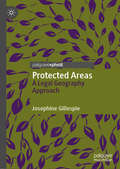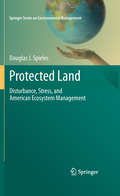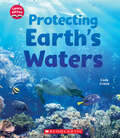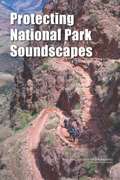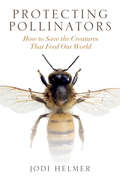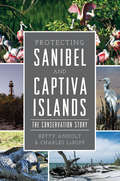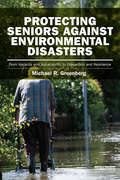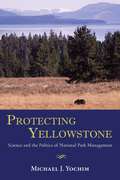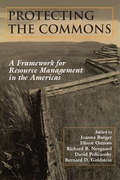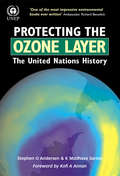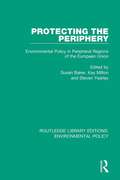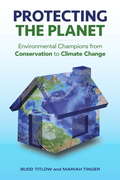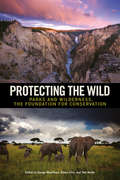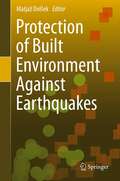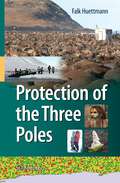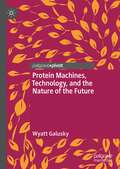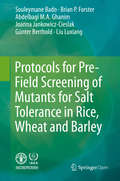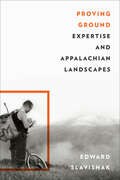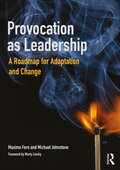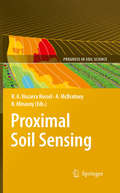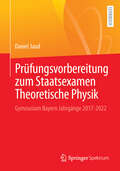- Table View
- List View
Protected Areas: A Legal Geography Approach
by Josephine GillespieThis book argues that legal geography provides new insights into contemporary conservation challenges. Despite unprecedented efforts, we are facing an extinction crisis, and in situ protected area programs are falling short. This book discusses the protected area phenomenon and calls for changes to current approaches, informed by legal geography –an inter-disciplinary area focused on the intertwined people–place–law dynamics that enable, or disable, effective management practices. The book examines two protected area types: World Heritage Sites, where places of ‘outstanding universal value’ are protected for all humanity, and Ramsar protected wetland sites, one of the first global environmental protection initiatives. Using case studies from the Australasian region (Australia, the Pacific and Southeast Asia), it reveals how current approaches can be improved by taking into account the people–place–law nexus embedded in legal geography research.
Protected Land
by Douglas J. SpielesThis is a book about ecosystems: the ways in which we perceive them, conceptualize them,protect them, and manipulate them. Ecosystems have been given considerable attention inrecent literature, and with good reason. Our growing comprehension of irreplaceable andimperiled ecosystem services has made it clear that we are in the midst of an ecological crisis.In response, various organizations, agencies, and individuals have dedicated themselves to thepreservation, restoration, and maintenance of ecological systems. The United States is a worldleader in this regard, building upon the legacy of giants like Thoreau, Muir, and Leopold.And yet, even as we scramble to rehabilitate and sustain ecosystems, the debate on their naturecontinues. In one corner are proponents of holism--those that see ecosystems as definableunits with recognizable and regenerative stable states.
Protecting Biological Diversity: The Effectiveness of Access and Benefit-sharing Regimes (Routledge Studies in Development and Society #24)
by Carmen RicherzhagenDuring the last ten years the enormous global loss of biodiversity has received remarkable attention. Among the numerous approaches undertaken to stop or lessen this process, access and benefit-sharing (ABS), a market-based approach, has emerged as among the most prominent. In theory, ABS turns biodiversity and genetic resources from an open access good to a private good and creates a market for genetic resources. It internalizes the resources’ positive externalities by pricing the commercial values for research and development and makes users pay for it. Users’ benefits are shared with the resource holders and set incentives for the sustainable use and the conservation of biodiversity. Carmen Richerzhagen, however, finds that in practice there are significant questions about the effectiveness of the approach in the protection of biodiversity and about the fair and equitable sharing of benefits arising from the commercialization. Utilizing the empirical findings of three case studies of biodiversity-providing countries - Costa Rica, the Philippines and Ethiopia - and one case study of a community of user countries, the European Union (EU), Richerzhagen examines the effectiveness of ABS through the realization of its own objectives.
Protecting Earth's Waters (Learn About)
by Cody CraneAn essential tool to teach kids about the importance of water!Did you know that water covers almost three-fourths of Earth’s surface? More than half the world’s creatures live in this water. And the rest cannot survive without it! That’s why it is so important to protect this vital resource, which has been threatened by pollution and other human-made dangers. Discover more about what is threatening Earth’s most precious resource, as well as what is being done to protect it, in Protecting Earth’s Waters.ABOUT THIS SERIES:Earth is known as the Blue Planet because of the abundant amount of water that covers our home. And nothing on Earth could survive without it. As we find ourselves facing a global water crisis, learning about this life-giving resource has never been more important. The books in this series are filled with colorful photos and diagrams, plus easy-to-digest text, and fascinating facts. And they offer young readers an in-depth look at what water is, how we use it, and most importantly, what we can do to protect it.
Protecting Life on Earth
by Peter B. Moyle Michael Paul MarchettiWritten to be accessible to any college-level reader, Protecting Life on Earth offers a non-technical, yet comprehensive introduction to the growing field of conservation science. This multifaceted exploration of our current biodiversity crisis delivers vivid examples throughout, including features on some of nature's most compelling wildlife. Beginning with a brief introduction to environmental history, the text introduces the central concepts of evolution and ecology, and covers several major issues related to the conservation of biodiversity including extinction, climate change, sustainability, conservation law, and invasive species. It also touches on adjacent disciples such as economics and sociology as they relate to conservation. The text even includes practical advice on the decisions we make every day--how we spend our money, where we live and work, what we eat and buy. Throughout, Protecting Life on Earth underscores the ways in which our future is tied to that of Earth's threatened species, and demonstrates exactly why conservation is so vitally important for us all.
Protecting National Park Soundscapes
by Proctor ReidAmerica's national parks provide a wealth of experiences to millions of people every year. What visitors see--landscapes, wildlife, cultural activities--often lingers in memory for life. And what they hear adds a dimension that sight alone cannot provide. Natural sounds can dramatically enhance visitors' experience of many aspects of park environments. In some settings, such as the expanses of Yellowstone National Park, they can even be the best way to enjoy wildlife, because animals can be heard at much greater distances than they can be seen. Sounds can also be a natural complement to natural scenes, whether the rush of water over a rocky streambed or a ranger's explanation of a park's history. In other settings, such as the New Orleans Jazz National Historical Park, sounds are the main reason for visiting a park. The acoustical environment is also important to the well-being of the parks themselves. Many species of wildlife depend on their hearing to find prey or avoid predators. If they cannot hear, their survival is jeopardized--and the parks where they live may in turn lose part of their natural heritage. For all these reasons it is important to be aware of noise (defined as unwanted sound, and in this case usually generated by humans or machinery), which can degrade the acoustical environment, or soundscape, of parks. Just as smog smudges the visual horizon, noise obscures the listening horizon for both visitors and wildlife. This is especially true in places, such as remote wilderness areas, where extremely low sound levels are common. The National Park Service (NPS) has determined that park facilities, operations, and maintenance activities produce a substantial portion of noise in national parks and thus recognizes the need to provide park managers with guidance for protecting the natural soundscape from such noise. Therefore, the focus of the workshop was to define what park managers can do to control noise from facilities, operations, and maintenance, and not on issues such as the effects of noise on wildlife, noise metrics, and related topics. To aid in this effort, NPS joined with the National Academy of Engineering (NAE) and with the US Department of Transportation's John A. Volpe National Transportation Systems Center to hold a workshop to examine the challenges and opportunities facing the nation's array of parks. Entitled "Protecting National Park Soundscapes: Best Available Technologies and Practices for Reducing Park- Generated Noise," the workshop took place October 3-4, 2012, at NPS's Natural Resource Program Center in Fort Collins, Colorado. Protecting National Park Soundscapes is a summary of the workshop.
Protecting Pollinators: How to Save the Creatures that Feed Our World
by Jodi HelmerWe should thank a pollinator at every meal. These diminutive creatures fertilize a third of the crops we eat. Yet half of the 200,000 species of pollinators are threatened. Birds, bats, insects, and many other pollinators are disappearing, putting our entire food supply in jeopardy. In North America and Europe, bee populations have already plummeted by more than a third and the population of butterflies has declined 31 percent.Protecting Pollinators explores why the statistics have become so dire and how they can be reversed. Jodi Helmer breaks down the latest science on environmental threats and takes readers inside the most promising conservation initiatives. Efforts include famers reducing pesticides, cities creating butterfly highways, volunteers ripping up invasive plants, gardeners planting native flowers, and citizen scientists monitoring migration. Along with inspiring stories of revival and lessons from failed projects, readers will find practical tips to get involved. They will also be reminded of the magic of pollinators—not only the iconic monarch and dainty hummingbird, but the drab hawk moth and homely bats that are just as essential. Without pollinators, the world would be a duller, blander place. Helmer shows how we can make sure they are always fluttering, soaring, and buzzing around us.
Protecting Sanibel and Captiva Islands: The Conservation Story (Natural History)
by Betty Anholt Charles LeBuffThe vibrant Sanibel and Captiva Islands are ecological marvels compared to Florida's many overbuilt barrier islands. Development began with the construction of the Sanibel Island Lighthouse in 1884, when only the lighthouse keeper and assistant and their families lived on the island. Noted conservationist Jay N. "Ding" Darling led the charge in preserving the islands' wildlife and natural beauty from the greed of real estate speculators and land developers in the 1930s. Former presidents like Harry Truman and cabinet-level executives worked alongside Sanibel and Captiva residents, setting up preserves and wildlife refuges to guard the integrity of the islands' unique natural blessings, abundant wildlife and aquatic stores. Charles LeBuff and Betty Anholt review the evolution of the islands' conservation ethic and how it perseveres even today.
Protecting Seniors Against Environmental Disasters: From Hazards and Vulnerability to Prevention and Resilience (Earthscan Risk in Society)
by Michael R GreenbergThe baby boom generation were born between 1946 and 1964 and are the largest population cohort in US history. They should number about 90 million by mid-century, more than doubling their current size. The massive increase in seniors and relative decline of those of working age in the US is mirrored in almost all the world’s most populous countries. This book connects the dots between the US baby boom generation and the marked increase in natural and human-caused disasters. It evaluates options available to seniors, their aids, for and not-for and for-profit organizations and government to reduce vulnerability to hazard events. These include coordinated planning, risk assessment, regulations and guidelines, education, and other risk management efforts. Using interviews with experts, cases studies, especially of Superstorm Sandy, and literature, it culls best practice and identify major gaps. It is original and successful in making the connection between the growing group of vulnerable US seniors, environmental events, and risk management practices in order to isolate the most effective lessons learned.
Protecting Yellowstone: Science and the Politics of National Park Management
by Michael J. YochimYellowstone National Park looks like a pristine western landscape populated by its wild inhabitants: bison, grizzly bears, and wolves. But the bison do not always range freely, snowmobile noise intrudes upon the park&’s profound winter silence, and some tourist villages are located in prime grizzly bear habitat. Despite these problems, the National Park Service has succeeded in reintroducing wolves, allowing wildfires to play their natural role in park forests, and prohibiting a gold mine that would be present in other more typical western landscapes.Each of these issues—bison, snowmobiles, grizzly bears, wolves, fires, and the New World Mine—was the center of a recent policy-making controversy involving federal politicians, robust debate with interested stakeholders, and discussions about the relevant science. Yet, the outcomes of the controversies varied considerably, depending on politics, science, how well park managers allied themselves with external interests, and public thinking about the effects of park proposals on their access and economies. Michael Yochim examines the primary influences upon contemporary national park policy making and considers how those influences shaped or constrained the final policy. In addition, Yochim considers how park managers may best work within the contemporary policy-making context to preserve national parks.
Protecting the Commons: A Framework For Resource Management In The Americas
by Joanna Burger Elinor Ostrom Bernard D. Goldstein David Policansky Richard NorgaardCommons -- lands, waters, and resources that are not legally owned and controlled by a single private entity, such as ocean and coastal areas, the atmosphere, public lands, freshwater aquifers, and migratory species -- are an increasingly contentious issue in resource management and international affairs.Protecting the Commons provides an important analytical framework for understanding commons issues and for designing policies to deal with them. The product of a symposium convened by the Scientific Committee on Problems of the Environment (SCOPE) to mark the 30th anniversary of Garrett Hardin's seminal essay "The Tragedy of the Commons" the book brings together leading scholars and researchers on commons issues to offer both conceptual background and analysis of the evolving scientific understanding on commons resources. The book: gives a concise update on commons use and scholarship offers eleven case studies of commons, examined through the lens provided by leading commons theorist Elinor Ostrom provides a review of tools such as Geographic Information Systems that are useful for decision-making examines environmental justice issues relevant to commons .Contributors include Alpina Begossi, William Blomquist, Joanna Burger, Tim Clark, Clark Gibson, Michael Gelobter, Michael Gochfeld, Bonnie McCay, Pamela Matson, Richard Norgaard, Elinor Ostrom, David Policansky, Jeffrey Richey, Jose Sarukhan, and Edella Schlager.Protecting the Commons represents a landmark study of commons issues that offers analysis and background from economic, legal, social, political, geological, and biological perspectives. It will be essential reading for anyone concerned with commons and commons resources, including students and scholars of environmental policy and economics, public health, international affairs, and related fields.
Protecting the Ozone Layer: The United Nations History
by Stephen O Andersen K Madhava SarmaIn the 1970s the world became aware of a huge danger: the destruction of the stratospheric ozone layer by CFCs escaping into the atmosphere, and the damage this could do to human health and the food chain. So great was the threat that by 1987 the UN had succeeded in coordinating an international treaty to phase out emissions; which, over the following 15 years has been implemented. It has been hailed as an outstanding success. It needed the participation of all the parties: governments, industry, scientists, campaigners, NGOs and the media, and is a model for future treaties. This volume provides the authoritative and comprehensive history of the whole process from the earliest warning signs to the present. It is an invaluable record for all those involved and a necessary reference for future negotiations to a wide range of scholars, students and professionals.
Protecting the Periphery: Environmental Policy in Peripheral Regions of the European Union (Routledge Library Editions: Environmental Policy #1)
by Steven Yearley Susan Baker Kay MiltonFirst published in 1994. ln Protecting the Periphery the editors present a series of papers revealing the impact of EU policies on environmental quality in regions at the edge of the European Union and in those lying just outside it. In many cases these regions contain habitats and landscapes of international importance; they have also often escaped some of the environmental damage caused by industrialization. But, as the papers' reveal, attempts by the EU to safeguard these environmental benefits are often contradicted by the EU’s own development policies, bringing air pollution from new roads, contamination from new industries, and leading to habitat destruction from modern agricultural practices and increases in tourism. As the Union pushes for the deepening of the integration process, including completing the internal market, the pressures on the periphery's environment are increasing. Furthermore, the efforts of the periphery to catch-up economically with the developed core can often heighten the tension between economic considerations on the one hand and the need for environmental protection on the other. The studies in this book examine the ambivalent responses to EU environmental policy among policy-makers and environmentalists in the periphery. Both the willingness as well as the capacity of the periphery to protect its environmental heritage are explored. In particular, the administrative capacity, institutional arrangements, political culture as well as economic development needs are taken into account in an examination of the nature of the periphery’s response to and implementation of Union environmental policy. The book will appeal to policy-makers and academics in the countries of the European periphery and to analysts of European policy-making everywhere, especially those concerned with environmental policy and politics.
Protecting the Planet: Environmental Champions from Conservation to Climate Change
by Budd Titlow Mariah TingerClimate change is often associated with predictions of dire calamities. But in the past, heroic individuals have stepped forward to meet even the most ominous ecological challenges. This book tells an inspirational story--a story both of pioneering environmentalists who raised our collective consciousness regarding nature's value and heroes of today who are working to secure a sustainable future.The authors begin with the mounting evidence for climate change as seen in rising carbon dioxide levels, higher global temperatures, melting ice sheets, and sea level rise. They then review the history of the US environmental movement, focusing on the key people who changed our understanding of the human impact on our natural surroundings. These include John James Audubon, Henry David Thoreau, John Burroughs, Theodore Roosevelt, John Muir, Bob Marshall, Roger Tory Peterson, Aldo Leopold, Rachel Carson, David Brower, Barry Commoner, Donella Meadows, and many more. Turning to the present, the authors recount the activities of people currently pursuing remedies for climate change--scientists, researchers, activists, artists, and celebrities. Much of this information is based on recent personal interviews.They conclude with a set of actionable strategies, demonstrating that there are good reasons to hope that we can achieve a sustainable lifestyle, protect our planet as our home, and ensure the future for our children.From the Hardcover edition.
Protecting the Wild
by Tom Butler George Wuerthner Eileen CristProtected natural areas have historically been the primary tool of conservationists to conserve land and wildlife. These parks and reserves are set apart to forever remain in contrast to those places where human activities, technologies, and developments prevail. But even as the biodiversity crisis accelerates, a growing number of voices are suggesting that protected areas are passé. Conservation, they argue, should instead focus on lands managed for human use--working landscapes--and abandon the goal of preventing human-caused extinctions in favor of maintaining ecosystem services to support people. If such arguments take hold, we risk losing support for the unique qualities and values of wild, undeveloped nature. Protecting the Wild offers a spirited argument for the robust protection of the natural world. In it, experts from five continents reaffirm that parks, wilderness areas, and other reserves are an indispensable--albeit insufficient--means to sustain species, subspecies, key habitats, ecological processes, and evolutionary potential. Using case studies from around the globe, they present evidence that terrestrial and marine protected areas are crucial for biodiversity and human well-being alike, vital to countering anthropogenic extinctions and climate change. A companion volume to Keeping the Wild: Against the Domestication of Earth, Protecting the Wild provides a necessary addition to the conversation about the future of conservation in the so-called Anthropocene, one that will be useful for academics, policymakers, and conservation practitioners at all levels, from local land trusts to international NGOs.
Protecting the Wild: Parks and Wilderness, the Foundation for Conservation
by Tom Butler George Wuerthner Eileen CristProtected natural areas have historically been the primary tool of conservationists to conserve land and wildlife. These parks and reserves are set apart to forever remain in contrast to those places where human activities, technologies, and developments prevail. But even as the biodiversity crisis accelerates, a growing number of voices are suggesting that protected areas are passé. Conservation, they argue, should instead focus on lands managed for human use--working landscapes--and abandon the goal of preventing human-caused extinctions in favor of maintaining ecosystem services to support people. If such arguments take hold, we risk losing support for the unique qualities and values of wild, undeveloped nature. Protecting the Wild offers a spirited argument for the robust protection of the natural world. In it, experts from five continents reaffirm that parks, wilderness areas, and other reserves are an indispensable--albeit insufficient--means to sustain species, subspecies, key habitats, ecological processes, and evolutionary potential. Using case studies from around the globe, they present evidence that terrestrial and marine protected areas are crucial for biodiversity and human well-being alike, vital to countering anthropogenic extinctions and climate change. A companion volume to Keeping the Wild: Against the Domestication of Earth, Protecting the Wild provides a necessary addition to the conversation about the future of conservation in the so-called Anthropocene, one that will be useful for academics, policymakers, and conservation practitioners at all levels, from local land trusts to international NGOs.
Protection of Built Environment Against Earthquakes
by Matjaž DolšekCurrent knowledge and state-of-the-art developments in topics related to the seismic performance and risk assessment of different types of structures and building stock are addressed in the book, with emphasis on probabilistic methods. The first part addresses the global risk components, as well as seismic hazard and ground motions, whereas the second, more extensive part presents recent advances in methods and tools for the seismic performance and risk assessment of structures. The book contains examples of steel, masonry and reinforced concrete buildings, as well as some examples related to various types of infrastructure, such as bridges and concrete gravity dams. The book's aim is to make a contribution towards the mitigation of seismic risk by presenting advanced methods and tools which can be used to achieve well-informed decision-making, this being the key element for the future protection of the built environment against earthquakes. Audience: This book will be of interest to researchers, postgraduate students and practicing engineers working in the fields of natural hazards, earthquake, structural and geotechnical engineering, and computational mechanics, but it may also be attractive to other experts working in the fields related to social and economic impact of earthquakes.
Protection of Global Biodiversity: Converging Strategies
by Jeffrey Mcneely Lakshman D. GuruswamyThe rate of extinction of biological species is greater today than at any time in the last 65 million years. Some predict that if this rate continues, two-thirds of all living species will disappear during the next century. Because reaching consensus on specific courses of action involves complex issues, any adequate response to this impending crisis must include coverage of many areas of inquiry and understanding. Protection of Global Biodiversity features essays by distinguished international experts who communicate with each other across disciplinary boundaries to address the challenge of formulating policies to protect biodiversity.Although the global community has recently adopted a Convention of Biological Diversity, the agreement sets forth only abstract goals. Contributors to this volume advance the Convention's initial steps by providing workable solutions that can be implemented regionally, nationally, and locally. The contributors--including natural, social, and political scientists; economists; lawyers; and environmentalists; and decisionmakers in business, agriculture, and government--have united to create a common discourse and to evaluate and propose strategies for halting this alarming loss of biodiversity. In recognizing the diverse aspects of this task--scientific, economic, institutional, moral, and legal--this book presents a new picture of emerging action.Contributors. S. James Anaya, Gregory Benford, Graciela Chichilnisky, S. Todd Crider, Yvonne Cripps, Robert T. Fraley, Anil K. Gupta, Lakshman D. Guruswamy, G. M. Heal, Brent Hendricks, Robert B. Horsch, Laura L. Jackson, Annie Lovejoy, Ariel E. Lugo, Jeffrey A. McNeely, Brian G. Norton, Elinor Ostrom, Peter H. Raven, John W. Reid, Walter V. Reid, Mark Sagoff, Roger A. Sedgo, R. David Simpson, Ana Sittenfeld, Christopher D. Stone, Gary H. Toenniessen
Protection of the Three Poles
by Falk HuettmannThe Arctic, the Antarctic, and the Hindu Kush-Himalayas form a trio of terrains sometimes called "the three poles". Mainly composed of rock, snow, and ice, these precious regions, which are home to many unique species such as the polar bear, the emperor penguin, and the snow leopard, contain the primary water resource of this planet and directly shape our climate. This book presents a first-ever global assessment and progressive review of the three poles and demonstrates the urgent need for their protection. Sins of the past have irrevocably harmed and threatened many of the unique qualities of these regions, and the future looks bleak with the global population forecast to reach 9 billion by 2060, and with climate change on the rise. Presented here is a wide-reaching and coherent overview of the three poles' biodiversity, habitats, and ongoing destruction. Failed protection and social targets set by the United Nations and other bodies are exposed while economic growth, unconstrained or inappropriate development, and urban sprawl are promoted unabated. Polar regions play a major role in the global agenda as they are rich in oil and other resources, marking them for contamination, overfishing, and further degradation. Tourism in the Antarctic has benefited from enlightened self-regulation, but there are signs that this is changing, too. The chapters of this book are written by experts in their fields, and their evidence leaves no doubt that we already live beyond our carrying capacity on a finite but decaying space. A global protection role model and several outlook scenarios are proposed to help set in motion polar protection priorities that are actually valid. Humanity has demonstrated through international treaties such as the Antarctic Treaty and the Madrid Protocol that we can put the interests of the planet as a whole first. This must become the norm, not the exception.
Protein Machines, Technology, and the Nature of the Future
by Wyatt GaluskyThis book explores the relationships between humans, chickens, and environments in the context of protein production. The history of these relationships reveals them to be increasingly technological, which results in humans becoming more responsible for those animals and their environments. Understanding this development through the configuration of various kinds of protein machines is key to confronting the kinds of future we wish to promote, and the characteristics of the present we wish to sustain. The book is organized around narratives that explore the concept of the protein machine, with a particular focus on the development of the chicken as it has moved from the field to the factory to the laboratory. These transformations are interconnected, and culminate in efforts to cultivate meat without the animal. Our ultimate goal will be to ask what kind of future does this technology envision, and what roles do humans and animals play in it?
Protocols for Pre-Field Screening of Mutants for Salt Tolerance in Rice, Wheat and Barley
by Souleymane Bado Brian P. Forster Abdelbagi M. A. Ghanim Joanna Jankowicz-Cieslak Günter Berthold Liu LuxiangThis book offers effective, low-costand user-friendly protocols for the pre-field selection of salt-tolerant mutants in cereal crops. It presents simple methods for measuring soil salinity, includingsoil sampling and the analysis of water-soluble salts, and describes adetailed, but simple, screening test for salt tolerance in rice, wheat andbarley seedlings, which uses hydroponics. The protocols are devised for use byplant breeders and can be easily accommodated into breeding practice.
Proving Ground: Expertise and Appalachian Landscapes
by Edward SlavishakDisrupting the intervenor narrative in Appalachian studies.The Appalachian Mountains attracted an endless stream of visitors in the twentieth century, each bearing visions of what they would encounter. Well before large numbers of tourists took to the mountains in the latter half of the century, however, networks of missionaries, sociologists, folklorists, doctors, artists, and conservationists made Appalachia their primary site for fieldwork. In Proving Ground, Edward Slavishak studies several of these interlopers to show that the travelers’ tales were the foundation of powerful forms of insider knowledge. Following four individuals and one cohort as they climbed professional ladders via the Appalachian Mountains, Slavishak argues that these visitors represented occupational and recreational groups that used Appalachia to gain precious expertise. Time spent in the mountains, in the guise of work (or play that mimicked work), distinguished travelers as master problem-solvers and transformed Appalachia into a proving ground for preservationists, planners, hikers, anthropologists, and photographers.Based on archival materials from outdoors clubs, trade journals, field notes, correspondence, National Park Service records, civic promotional materials, and photographs, Proving Ground presents mountain landscapes as a fluid combination of embodied sensation, narrative fantasy, and class privilege. Touching on critical regionalism and mobility studies, this book is a boundary-pushing cultural history of expertise, an environmental history of the Appalachian Mountains, and a historical geography of spaces and places in the twentieth century.
Provocation as Leadership: A Roadmap for Adaptation and Change
by Maxime Fern Michael JohnstoneTo create deep change, you have to disturb people, or at least risk doing so. Shaking people out of their comfort zones not only generates the possibility of change but also elicits new information and brings out hidden resources that people need to navigate unfamiliar waters. Nevertheless, provoking without antagonizing or shutting people down and tolerating their pushback are complex challenges, requiring skill and will. This is the first comprehensive provocation roadmap: why provocation is necessary for effectively leading change, the different forms of provocation, action tools and frameworks, and case studies illustrating how change is achieved through the sustained and careful use of provocation and disturbance, with strategies and tactics for minimizing the risks involved. We illustrate, for example, how two Australian farmers challenged centuries-old farming practice to regenerate their properties and how a large American bank used the death of a revered CEO to reinvigorate the business. We show how a young indigenous school principal tackled entrenched attitudes to turn a failing school around and how a national statistical service acted like a technology start-up to innovate during the Covid-19 pandemic. The case studies address change at the local level, within organizations, as well as on a national scale. We finish with a synthesis of the lessons learned and a set of ideas about building people’s capacity to use provocation to live, learn, and thrive. Provocation as Leadership offers a blueprint for people who, using provocation, want to ignite change and help their organizations, group, or community break through to a better future. This book provides a vehicle to see provocation in its potential for necessary disturbance, to lay bare its anatomy, and give access to its possibilities, including how to enable provocateurs to live another day.
Proximal Soil Sensing
by Alex B. Mcbratney Budiman Minasny Raphael A. Viscarra RosselThis book reports on developments in Proximal Soil Sensing (PSS) and high resolution digital soil mapping. PSS has become a multidisciplinary area of study that aims to develop field-based techniques for collecting information on the soil from close by, or within, the soil. Amongst others, PSS involves the use of optical, geophysical, electrochemical, mathematical and statistical methods. This volume, suitable for undergraduate course material and postgraduate research, brings together ideas and examples from those developing and using proximal sensors and high resolution digital soil maps for applications such as precision agriculture, soil contamination, archaeology, peri-urban design and high land-value applications, where there is a particular need for high spatial resolution information. The book in particular covers soil sensor sampling, proximal soil sensor development and use, sensor calibrations, prediction methods for large data sets, applications of proximal soil sensing, and high-resolution digital soil mapping. Key themes: soil sensor sampling - soil sensor calibrations - spatial prediction methods - reflectance spectroscopy - electromagnetic induction and electrical resistivity - radar and gamma radiometrics - multi-sensor platforms - high resolution digital soil mapping - applications Raphael A. Viscarra Rossel is a scientist at the Commonwealth Scientific and Industrial Research Organisation (CSIRO) of Australia. Alex McBratney is Pro-Dean and Professor of Soil Science in the Faculty of Agriculture Food & Natural Resources at the University of Sydney in Australia. Budiman Minasny is a Senior Research Fellow in the Faculty of Agriculture Food & Natural Resources at the University of Sydney in Australia.
Prüfungsvorbereitung zum Staatsexamen Theoretische Physik: Gymnasium Bayern Jahrgänge 2017-2022
by Daniel JaudDieses Lehrbuch beinhaltet die Examensaufgaben und Lösungsvorschläge zur theoretischen Physik für das Lehramt an Gymnasien in Bayern. Da das Rechnen von Aufgaben eine zentrale Prüfungsvorbereitung darstellt, stehen in diesem Buch ausgearbeitete Lösungen zur Verfügung, um einen maximalen Lernerfolg zu erzeugen. Zusätzlich liefert das Buch zu Beginn ein kurzes Repetitorium zu allen vier großen Themenbereichen, welche im Staatsexamen geprüft werden: die klassische Mechanik, die Elektrodynamik, die Thermodynamik und statistische Physik sowie die Quantenmechanik. Das Repetitorium zu den einzelnen Themenbereichen ist dabei so gestaltet, dass nur die absolut prüfungsrelevanten Kenntnisse nochmals aufgefrischt, wiederholt und an wichtigen exemplarischen Beispielen illustriert werden. Damit liefert dieser erste Teil des Buches eine kompakte Wissenszusammenfassung aller wesentlichen theoretischen Konzepte, welche im Staatsexamen beherrscht werden sollten. Der zweite Teil des Buches mit über 96 Prüfungsangaben und ausgearbeiteten Lösungen stellt eine der umfangreichsten Sammlungen zum Staatsexamen in der theoretischen Physik dar. Dadurch, dass sich die Lösungen gleich im Anschluss zur entsprechenden Aufgabe befinden, wird es Leserinnen und Lesern ermöglicht, schnell eigene Ergebnisse beim Durcharbeiten der Aufgaben zu überprüfen und wichtige Erkenntnisse zu erlangen.
